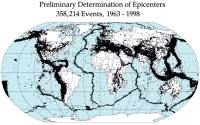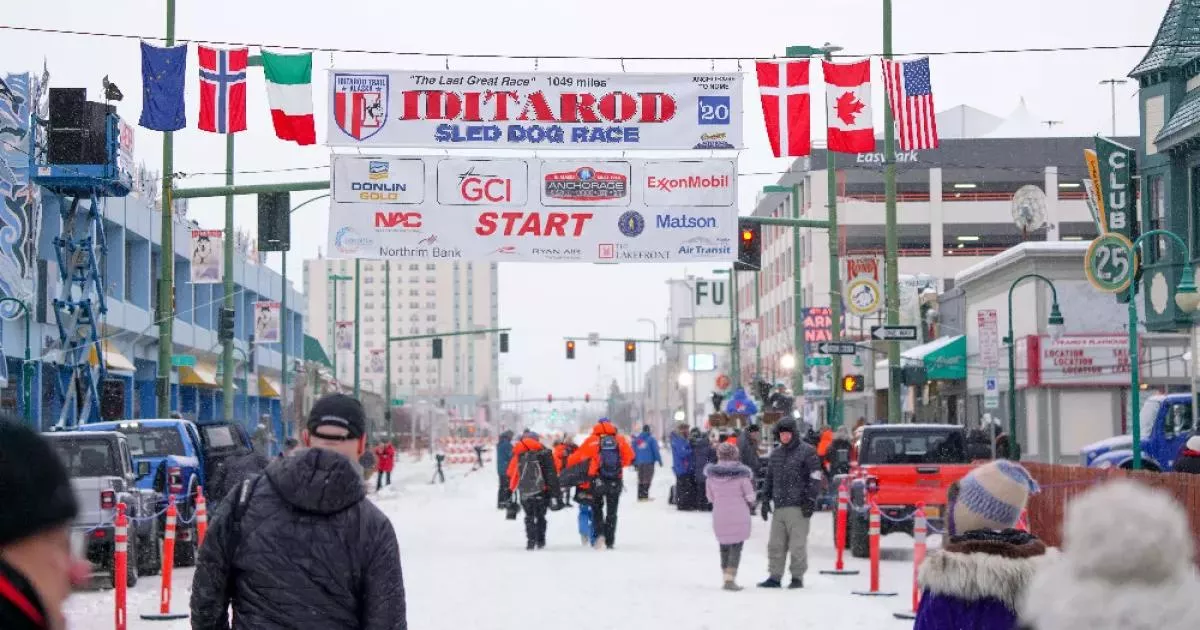The Iditarod Trail Sled Dog Race is an annual long-distance sled dog race in Alaska, held in early March, running from Anchorage to Nome. Mushers, with a team of 12-16 dogs (at least 5 at the finish), complete the distance in 8-15 days. Originating in 1973, it began as a test for mushers and teams, evolving into a competitive race.
1908: Trail Survey
In 1908, Walter Goodwin first surveyed the main route of the Iditarod trail.
1908: Gold Rush at the Inland Empire
In 1908, a gold rush occurred at the "Inland Empire" along the Kuskokwim Mountains, between the Yukon and Kuskokwim rivers.
1908: Inaugural All-Alaska Sweepstakes
In 1908, the first major sled dog competition, the All-Alaska Sweepstakes, was held, running 408 miles from Nome to Candle and back.
1910: Iditarod Mining District
In 1910, Iditarod became the center of the Inland Empire's Iditarod Mining District after being an Athabaskan village.
1910: Introduction of Siberian Huskies
In 1910, Siberian Huskies were introduced to Alaska through the All-Alaska Sweepstakes, quickly becoming the favored racing dog.
1911: Clearing and Marking
Between 1911 and 1912, the Alaska Road Commission cleared and marked the main route of the Iditarod Trail.
1912: Clearing and Marking
Between 1911 and 1912, the Alaska Road Commission cleared and marked the main route of the Iditarod Trail.
1924: McGrath receives first mail by aircraft
In 1924, McGrath became the first site in Alaska to receive mail by aircraft, marking a shift away from sled dogs and signaling the end of the sled dog era for mail delivery.
1925: Iditarod origins in 1925 serum delivery
Animal protection activists claim that the Iditarod race is not a commemoration of the 1925 serum delivery, as the original event was called the Iditarod Trail Seppala Memorial Race, honoring Leonhard Seppala.
1925: Serum Run and Balto
The start of the Iditarod race had no connection to the 1925 serum run to Nome or the dog Balto.
1928: Norman Vaughan participates in expedition to South Pole
In 1928, Norman Vaughan drove a dog team in Richard E. Byrd's expedition to the South Pole. He later competed in the only Olympic sled dog race.
1964: Earthquake affects Iditarod route
In 1964, the Good Friday earthquake made Rainy Pass inaccessible, forcing the Iditarod route to detour through Ptarmigan Pass, also known as Hellsgate, until Rainy Pass became accessible in 1976.
October 1972: Planning the Iditarod
In October 1972, Joe Redington Sr., Gleo Huyck, and Tom Johnson started planning the inaugural Iditarod race.
1973: Original Race Course
During the first Iditarod races in 1973 and 1974, the teams crossed the mudflats of Cook Inlet to Knik.
1973: Dick Wilmarth wins first race
In 1973, Dick Wilmarth won the inaugural Iditarod race with a time of 20 days, 0 hours, 49 minutes, and 41 seconds.
1973: Terry Miller and team rescued from overflow
In 1973, during the Iditarod race, Terry Miller and his team were almost pulled into a hole in the Kuskokwim River's overflow by a strong current but were rescued by Tom Mercer, who returned to save them.
1973: Inaugural Iditarod Race
In 1973, the Iditarod Trail Sled Dog Race was established as an event to test sled dog mushers and teams, marking the beginning of what would become a highly competitive race from Anchorage to Nome, Alaska.
1973: First Iditarod race completed
In 1973, the inaugural Iditarod race was completed, with the winner finishing in just over 20 days, marking the beginning of a new era in sled dog racing.
1973: Criticism regarding dog welfare
Since its inception in 1973, the Iditarod Trail Sled Dog Race has faced criticism regarding the welfare of participating dogs.
1974: Original Race Course
During the first Iditarod races in 1973 and 1974, the teams crossed the mudflats of Cook Inlet to Knik.
1974: Mary Shields Completes the Race
In 1974, Mary Shields became the first woman to complete the Iditarod race, finishing in 23rd place.
1974: Extreme weather conditions lead to frostbite cases
In 1974, extreme weather conditions during the Iditarod race resulted in several cases of frostbite. Temperatures dropped to −50 °F (−46 °C), and winds of 50 miles per hour (80.5 km/h) caused wind chills to plummet to −130 °F (−90 °C).
1974: Increased Musher Participation
In 1974, the Iditarod race saw an increase in musher participation, with 44 mushers joining despite a decrease in the race's purse.
1975: Vaughan hospitalized for frostbite
In 1975, Vaughan was hospitalized for frostbite after running through an overflow on the south fork of the Kuskokwim River during the Iditarod race.
1975: Corporate Sponsorship
In 1975, corporate sponsorship put the Iditarod race on secure financial footing.
1975: Original burled arch used
In 1975, the Red "Fox" Olson Trail Monument, or "burled arch", marked the official finish line in Nome for the Iditarod Trail Sled Dog Race.
1976: Accessibility of Rainy Pass changes Iditarod route
In 1976, Rainy Pass became accessible, changing the Iditarod route. Before 1976, the Iditarod route detoured through Ptarmigan Pass, also known as Hellsgate, due to the 1964 Good Friday earthquake.
1976: Wildfire creates hazards in Farewell Burn
In 1976, a wildfire burned 360,000 acres (1,500 km2) of spruce in the Farewell Burn area, creating hazards for Iditarod teams, forcing them to move slowly and risking paw injuries to the dogs.
1976: Norman Vaughan lost near Rainy Pass
In 1976, retired colonel Norman Vaughan, a veteran of Richard E. Byrd's 1928 South Pole expedition, became lost for five days after departing from Rainy Pass during the Iditarod race. He narrowly escaped death.
1976: Dog Abuse Scandal
In 1976, the Iditarod race experienced the loss of sponsors due to a dog-abuse scandal, but recreational mushing was still spurred as a result of the Iditarod.
1977: Addition of Southern Route
In 1977, the southern route was added to the Iditarod race to distribute the impact of the event on smaller villages.
1978: Iditarod Trail Designation
In 1978, the Iditarod Trail was designated as one of the first four US National Historic Trails.
1978: Closest finish in Iditarod history
In 1978, the Iditarod race saw its closest finish, with Dick Mackey declared the winner just one second ahead of Rick Swenson. The win was controversial because the nose of Mackey's lead dog crossed the finish line before Swenson's lead dog.
1982: Teams chased into the forest by a charging moose
In 1982, Dick Mackey, Warner Vent, Jerry Austin, and their dog teams were forced into the forest by a charging moose during the Iditarod race. This incident highlights the dangers posed by wildlife encounters on the trail.
1982: Rick Swenson's First Four Wins
In 1982, Rick Swenson became the first musher to win the Iditarod Trail Sled Dog Race four times.
1983: Race Start Location Change
In 1983, the Iditarod race start location was moved to Fourth Avenue in downtown Anchorage from Mulcahy Park.
1984: Veterinary exams implemented for dogs
In 1984, the Iditarod Trail Sled Dog Race began requiring all participating dogs to undergo veterinary examinations before the start of the race. These exams include checks on teeth, eyes, tonsils, heart, lungs, joints, and genitals, as well as screening for illegal drugs, improperly healed wounds, and pregnancy.
1985: Jerry Austin suffers injuries at Rainy Pass
During the 1985 Iditarod, Jerry Austin broke a hand, and two of his dogs sustained injuries when his sled went out of control and collided with trees at the perilous Rainy Pass checkpoint.
1985: Libby Riddles' Victory
In 1985, Libby Riddles became the first woman to win the Iditarod race, which brought increased attention to the event outside of Alaska.
1985: Moose encounter leads to dog fatalities
In 1985, Susan Butcher's Iditarod bid was thwarted when her team encountered a pregnant moose, resulting in the deaths of two dogs and serious injuries to six others. The incident occurred in "moose alley" near Willow.
1985: Race Suspension
In 1985, the Iditarod race was suspended for the first time due to weather preventing supply delivery, causing mushers and dogs to congregate at Rainy Pass.
1986: Susan Butcher's dogs fall through ice
In 1986, Susan Butcher's lead dogs fell through the ice on the Tatina River, but landed on a second layer of ice, averting a more serious incident during the Iditarod.
1988: Peryll Kyzer falls through ice bridge
In 1988, Iditarod rookie Peryll Kyzer fell through an ice bridge into a creek while navigating Dalzell Gorge and spent the night wet, highlighting the perilous conditions of the trail.
1991: Close races in Iditarod history
By 1991, the Iditarod race had been decided by less than an hour seven times, and less than five minutes three times, underscoring the competitive nature of the event.
1991: Rick Swenson's Fifth Win
In 1991, Rick Swenson achieved a record as the first person to win the Iditarod five times and the only musher to win in three different decades.
1992: First Foreign Winner
In 1992, Martin Buser from Switzerland became the first foreign winner of the Iditarod race.
1992: Martin Buser's Win
In 1992, Martin Buser, a Swiss resident of Alaska since 1979, became the first foreigner to win the Iditarod race.
1995: Doug Swingley's Win
In 1995, Doug Swingley from Montana became the first non-Alaskan to win the Iditarod Trail Sled Dog Race.
1995: Addition of Restart Location
In 1995, a restart location was added to the Iditarod route.
1996: Shift to Rainy Pass
In 1996, the Iditarod route shifted from Ptarmigan to Rainy Pass.
1996: Winning time drops below 10 days
Since 1996, improvements in trail preparation and dog training have consistently brought the winning time of the Iditarod race to under 10 days, a significant reduction from the 20+ days of the inaugural race in 1973.
1997: Ramey Smyth loses part of his finger
In 1997, Ramey Smyth lost the end of his little finger when it struck an overhanging branch while negotiating the treacherous Dalzell Gorge section of the Iditarod Trail.
2001: Original burled arch destroyed
In 2001, the original burled arch, used as the finish line of the Iditarod race, was destroyed due to dry rot and years of inclement weather.
2002: Martin Buser Becomes a U.S. Citizen
Following the 2002 Iditarod race, Martin Buser became a naturalized U.S. citizen in a ceremony under the Burled Arch in Nome.
2002: Wasilla Restart Change
In 2002, the official restart of the Iditarod race was moved from Wasilla due to insufficient snow conditions.
2003: Robert Sørlie's Win
In 2003, Norwegian Robert Sørlie became the first non-resident of the United States to win the Iditarod race.
2003: Start Moved to Fairbanks
In 2003, the start of the Iditarod race was moved 300 miles north to Fairbanks due to dwindling snow and poor trail conditions caused by a warming climate.
2004: Race Restart Time Change
In 2004, the Iditarod race restart time was moved from 10:00 a.m. to 2:00 p.m. AST to ensure that the dogs would start in colder weather.
2004: Willow Named New Restart
Since 2004, Willow became the official restart location for the Iditarod race due to the lack of snow in the prior location.
2005: Iditarod claims no musher banned for dog drugging
As of 2005, the Iditarod organization claimed that no musher had ever been banned for administering drugs to their dogs during the race, although the results of drug tests on the dogs are never revealed.
2005: Checkpoint Change
In 2005, the Iditarod checkpoint was changed from Eagle River to Campbell Airstrip due to weather conditions.
2006: Estimated costs for participating in the race
As of 2006, the combined cost of entry fees, dog maintenance, and transportation for the Iditarod was estimated to be between US$20,000 and $30,000 per musher, varying with the number of dogs, feed, housing, and handlers.
May 18, 2007: Ramy Brooks suspended for dog abuse
On May 18, 2007, the Iditarod Trail Committee Board of Directors announced the suspension of Ramy Brooks for abusing his sled dogs. The suspension was effective for the 2008 and 2009 races, followed by three years of probation.
2007: Lance Mackey's Double Win
In 2007, Lance Mackey achieved a milestone by becoming the first musher to win both the Yukon Quest and the Iditarod in the same year.
2008: Lance Mackey Repeats Double Win
In 2008, Lance Mackey repeated his achievement from the previous year, winning both the Yukon Quest and the Iditarod, and also joined his father and brother as an Iditarod champion.
2008: Ramy Brooks' suspension begins
In 2008, Ramy Brooks began his suspension from the Iditarod Trail Sled Dog Race for abusing his sled dogs, a suspension that was announced by the Iditarod Trail Committee Board of Directors on May 18, 2007.
2008: Golden Harness Awarded to Babe
In 2008, the "Golden Harness," typically awarded to the lead dog of the winning team, was given to Babe, Ramey Smyth's lead dog, who finished in third place. Babe was almost 11 years old and had completed her ninth Iditarod.
2008: Restart Location Change to Willow Lake
In 2008, the official Iditarod restart was pushed further north to Willow Lake.
2009: Second year of Ramy Brooks' suspension
In 2009, Ramy Brooks served the second year of his suspension from the Iditarod Trail Sled Dog Race for abusing his sled dogs. The suspension was followed by three years of probation.
2010: McGrath's population according to the census
According to the 2010 census, McGrath had a population of 401, making it the largest checkpoint in the Interior along the Iditarod Trail.
2010: Winner's purse for the race
In 2010, the winner of the Iditarod received $50,000, which was less than the $69,000 awarded to top finishers in the past, with some attributing this to a potential decline in overall interest in the race.
2012: Races decided by less than an hour
In 2012, the Iditarod was among numerous races that had been decided by less than an hour, highlighting the competitive nature of the event.
2013: Races decided by less than an hour
In 2013, the Iditarod was among numerous races that had been decided by less than an hour, highlighting the competitive nature of the event.
2013: Purse Distribution
In 2013, the total purse for the Iditarod race was US$600,000, divided among the top 30 finishers, with each finisher below 30th place receiving $1,049.
2014: Close finish at the Iditarod race
The 2014 Iditarod race saw a very close finish, with the finishing times of the top mushers being less than three minutes apart, highlighting the competitive nature of the event.
2015: Champion's Prize
As of 2015, the champion of the Iditarod race receives a new pickup truck and $69,000.
2015: Re-routing due to Lack of Snow
In 2015, the Iditarod race was re-routed and started in Fairbanks, Alaska due to lack of snow.
2015: Official Restart Moved to Fairbanks
In 2015, the official restart of the Iditarod had to again be moved north to Fairbanks due to unusually warm temperatures and lack of snow coverage on critical parts of the trail.
2016: Ceremonial Start Change
In 2016, the Iditarod race's ceremonial start was 3 miles in Anchorage, due to a lack of snow.
2016: Races decided by less than an hour
In 2016, the Iditarod was among numerous races that had been decided by less than an hour, highlighting the competitive nature of the event.
2017: Mitch Seavey's Record
In 2017, Mitch Seavey set a new record for the fastest Iditarod time, finishing in 8 days, 3 hours, 40 minutes, and 13 seconds, also becoming the oldest winner to date.
2017: Mitch Seavey sets fastest winning time
In 2017, Mitch Seavey set a new record for the fastest winning time in the Iditarod, completing the race in 8 days, 3 hours, 40 minutes, and 13 seconds.
2017: Wells Fargo ends Iditarod sponsorship
In 2017, Wells Fargo announced its decision to discontinue its sponsorship of the Iditarod race. While the company did not provide specific reasons, it was believed to be linked to allegations of cruelty to dogs.
2017: Re-routing due to Lack of Snow
In 2017, the Iditarod race was re-routed and started in Fairbanks, Alaska due to lack of snow.
2019: Races decided by less than an hour
In 2019, the Iditarod was among numerous races that had been decided by less than an hour, highlighting the competitive nature of the event.
2019: Last fatalities before 2024 Iditarod
In the 2019 Iditarod Trail Sled Dog Race, there were no dog fatalities. The next dog fatalities would not occur until the 2024 race, when three dogs died.
2020: Companies withdraw sponsorship
In 2020, multiple major companies withdrew their sponsorship of the Iditarod race following pressure from PETA, highlighting concerns regarding animal welfare.
2021: Dallas Seavey sets fastest winning time
In 2021, Dallas Seavey broke his father's record and set a new fastest winning time for the Iditarod with a time of 7 days, 14 hours, 8 minutes and 57 seconds.
2021: Dallas Seavey's Record
In 2021, Dallas Seavey broke the fastest Iditarod time record, finishing in 7 days, 14 hours, 8 minutes, and 57 seconds.
2021: Exxon withdraws financial support
In 2021, Exxon announced that it would discontinue its financial support of the Iditarod race following pressure from animal rights activists, highlighting concerns regarding animal welfare.
2021: Modified Route due to COVID-19
In 2021, the Iditarod race followed a modified 832-mile out-and-back route, the Gold Trail Loop, due to the COVID-19 pandemic.
2022: Millennium Hotels and Resorts drops sponsorship
Following the 2022 race, Millenium Hotels and Resorts ended their national sponsorship of the Iditarod race.
2022: Northern route used in even-numbered years
In 2022, being an even-numbered year, the northern route of the Iditarod Trail was used, a practice followed in even-numbered years since the addition of the southern route.
2023: Southern route used in odd-numbered years
In 2023, being an odd-numbered year, the southern route of the Iditarod was used. The two routes diverge after Ophir and rejoin at Kaltag.
2024: Dallas Seavey's Record Sixth Win
In 2024, Dallas Seavey secured a record-breaking sixth win in the Iditarod race, surpassing all previous mushers.
2024: PETA and Sporting News Articles
In 2024, articles by PETA and Sporting News covered topics related to the Iditarod race.
2024: Northern route used in even-numbered years
In 2024, being an even-numbered year, the northern route of the Iditarod Trail was used. The race alternates between a northern and southern route depending on whether it is an even or odd-numbered year.
2024: Dog fatalities during the race
In the 2024 Iditarod race, three dogs—Henry, George, and Bog—died during the event, marking the first fatalities since 2019. This brought the estimated total of dog deaths during the race to over 150 since its inception in 1973.
2025: Non-Standard Route Due to Lack of Snow
In 2025, the Iditarod race took another non-standard route, the longest in the race's history at 1,128 miles, from Fairbanks to Nome due to a lack of snow, with a southward loop on the Yukon River.
Mentioned in this timeline

Wells Fargo Company is a multinational financial services institution operating...

An earthquake is the shaking of the Earth's surface caused...

News encompasses information about current events disseminated through various media...

Dallas is a major city in Texas United States and...

An empire is a political structure consisting of a dominant...

Good Friday is a Christian holiday commemorating the crucifixion and...
Trending

1 month ago Stephen Curry's Emotional Bond and Support for Draymond Green Amidst Challenges.

9 months ago Fiala shines in NHL Playoffs; Kings defeat Oilers after dramatic comeback.

3 months ago Miles Teller Returns to Host SNL; Nikki Glaser & Glen Powell Debut

5 months ago Dwyane Wade Defends Legacy Amidst James Harden, Bradley Beal Debate and Clippers Move

8 months ago Payton Pritchard's plan for Celtics bounce-back against Magic, Horford talk, big plays.
3 months ago Mel Brooks faces criticism for Hitler joke and UWEC stages his musical.
Popular

Stranger Things created by the Duffer Brothers is a popular...

XXXTentacion born Jahseh Dwayne Ricardo Onfroy was a controversial yet...

Kelsey Grammer is an accomplished American actor producer and singer...

Candace Owens is an American conservative political commentator and author...

Melania Trump a Slovenian-American former model has served as First...

Bernie Sanders is a prominent American politician currently serving as...
